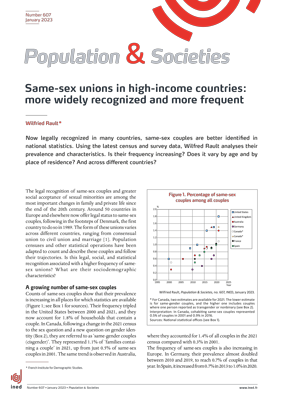Same-sex unions in high-income countries: more widely recognized and more frequent
Press release Published on 23 January 2023
Population & Societies no. 607, January 2023

Author: Wilfried Rault
Now legally recognized in many countries, same-sex couples are better identified in national statistics. Using the latest census and survey data, Wilfried Rault analyses their prevalence and characteristics. Is their frequency increasing? Does it vary by age and place of residence? And across different countries?
The frequency of cohabiting same-sex couples tripled in the United States between 2000 and 2021, and they now account for 1.8% of households containing a couple. The same trend is observed in Australia, where they accounted for 1.4% of all couples in the 2021 census compared with 0.3% in 2001. In Spain, their prevalence increased from 0.7% in 2013 to 1.0% in 2020, and in the United Kingdom from 1.0% in 2015 to 1.4% in 2018. In metropolitan France, 305,000 people were in a cohabiting same-sex couple in 2020, representing 1% of cohabiting couples in that year, up from 170,000 in 2011, and an increase of 80%. The number of same-sex couples has increased more markedly for lesbian couples than for gay couples. Partners in same-sex couples are younger on average, than those in different-sex couples.
They are also more urban: in the Western countries studied, same-sex couples are often concentrated in the largest metropolitan areas. In France, their prevalence is particularly high in Paris and the surrounding region, and to a lesser extent in the country’s other major cities. This overrepresentation in Paris decreased somewhat between 2011 and 2020.
People in same-sex unions, men especially, are less likely to live with children than people in different-sex unions, although the number of same-sex families is increasing. In this respect, as with place of residence, same-sex couples are very gradually becoming more similar to different-sex couples.
Published on: 25/01/2023








